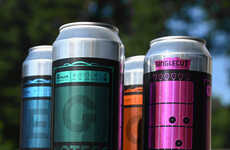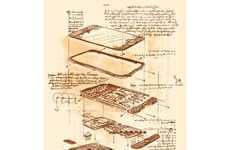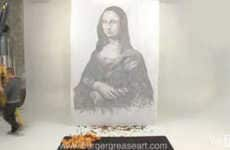
Last Supper's Secret Song Decoded
Ben Preiss — November 12, 2007 — Pop Culture
References: neatorama & dsc.discovery
By plotting the positions of the loaves of bread and the apostles' hands in Leonardo Da Vinci's painting, The Last Supper, musician Giovanni Maria, has reportedly found the notes of a musical score.
This reminds me of the people that were playing Beatle's albums backwards and decided that Paul was dead along with other things or the satanic messages that the religious right hear in other rock songs.
Pala goes beyond that and connects the “notes†that then “produced strange symbols -- similar to ancient cuneiform script.†Pala then brings this to biblical scholar, Antonianum Pontifical who concludes: the cuneiform writing turns out to be a sentence written in ancient Hebrew: "bo nezer usbi," which he translates to "with Him consecration and glory." I have a few of problems with this, first Hebrew is not written in cuneiform and second “nezer†translates to abstinence and not consecration and that is if you take the leap from hands and loaves to notes to cuneiform to Hebrew letters.
Pala doesn't stop there though, he goes on to place the nine Hebrew letters on top of each other and line them up “following an ascending path, which is the direction of the hands of the first six Apostles. The result was a strange image.â€
He noticed that on the table, to the right, Leonardo painted a piece of bread split in half.
"I thought of this as a hint to duplicate that image," Pala said. The resulting image -- nine letters stacked on top of each other and duplicated -- was the chalice.
This guy is trippin' on some heavy sh#t, you know he's going to see John the Baptist in his pizza and the Pope under his bed tonight.
This reminds me of the people that were playing Beatle's albums backwards and decided that Paul was dead along with other things or the satanic messages that the religious right hear in other rock songs.
Pala goes beyond that and connects the “notes†that then “produced strange symbols -- similar to ancient cuneiform script.†Pala then brings this to biblical scholar, Antonianum Pontifical who concludes: the cuneiform writing turns out to be a sentence written in ancient Hebrew: "bo nezer usbi," which he translates to "with Him consecration and glory." I have a few of problems with this, first Hebrew is not written in cuneiform and second “nezer†translates to abstinence and not consecration and that is if you take the leap from hands and loaves to notes to cuneiform to Hebrew letters.
Pala doesn't stop there though, he goes on to place the nine Hebrew letters on top of each other and line them up “following an ascending path, which is the direction of the hands of the first six Apostles. The result was a strange image.â€
He noticed that on the table, to the right, Leonardo painted a piece of bread split in half.
"I thought of this as a hint to duplicate that image," Pala said. The resulting image -- nine letters stacked on top of each other and duplicated -- was the chalice.
This guy is trippin' on some heavy sh#t, you know he's going to see John the Baptist in his pizza and the Pope under his bed tonight.
Trend Themes
1. Hidden Music in Artwork - Identifying hidden music in other paintings, sculptures or artwork may have the potential to unlock further artistic, cultural or historical revelations.
2. Cross-disciplinary Collaborations - Musicians, art historians, linguists and technologists partnering up may allow for new connections and discoveries in various fields.
3. Augmented Reality Art Interpretations - Using AR technology to overlay layers of information on top of artwork may provide new perspectives and insights into the artistic process and history.
Industry Implications
1. Art - Artists and art historians may collaborate with musicians and technologists to unlock new insights and connections in various artworks and artistic movements.
2. Music - Musicians like Giovanni Maria may continue to explore new ways music intersects with other art forms and media.
3. Technology - Augmented Reality technology may have applications in art interpretation and historical research.
5.4
Score
Popularity
Activity
Freshness























